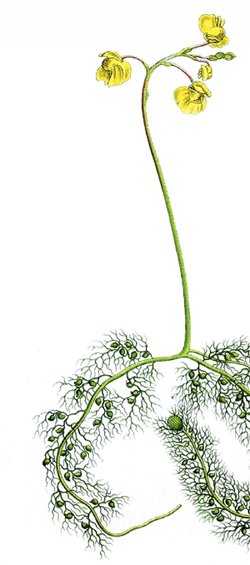
Bladderworts—Fastest Trap in the West
Design in Nature
The fastest trap in the West is not set by Western trappers seeking pelts. This marvel of miniature design is set by tiny plants, called bladderworts, which seek to supplement their diet.
“As fast as a jack rabbit” is a common expression. Such fleet-footed animals set the mark for exhilarating speed. We don’t usually go looking at plants for examples of speed. However, one type of carnivorous plant captures prey faster than the blink of an eye. Indeed, it’s the fastest known trap on the planet.
Bladderworts live in wet, nutrient-poor environments. We’re not sure when God gave them these special traps—perhaps they appeared at the time of the Curse (Genesis 3:14, 3:17–18; Romans 8:22), or perhaps the traps served a different purpose before the Fall. This is a question inquisitive creationists are currently investigating. But regardless, their design is an ongoing cause for wonder. Not only are they the fastest traps in the world, they’re also the most sophisticated.

If you’ve ever seen bladderworts, the tiny orchid-like flowers, not the traps, probably caught your eye. Their “leaves” and traps are either hidden under the soil or very low to the soil (in land-dwelling species), or they lie beneath the water (in aquatic species).
The traps are attached to what you might think look like roots. But bladderworts don’t have roots. Instead, their bodies consist of thin stem-like structures that can be several inches to several feet long. The round traps (bladders), which can number in the thousands, are attached to filament-like leaves by short “stalks.”
The way these traps operate boggles the mind. First, they appear to produce a chemical—a wonder all by itself—that attracts tiny creatures. Then each bladder has hair-like structures that guide these tiny creatures, such as protozoa, toward a half-moon-shaped door. The door is hinged along its top and can only swing inward.
When a trap is set, the sides of the bladder are curved inward, creating suction within its walls. A gooey substance is secreted that seals the door tightly, protecting the vacuum-like pressure within. Trigger hairs are positioned just outside the door. When a water flea, mosquito larva, tadpole, or other creature touches a trigger hair, a message is instantly sent to the trapdoor, causing it to swing inward, sucking the prey and a small amount of water into the bladder.
At the same time, the sides of the bladder spring outward, similar to how a vacuum cleaner bag bulges when the power is switched on. The door then snaps shut. The entire process takes place in approximately 1/1000th of a second! Over the next several minutes, the door is resealed, the water is pumped out, and the suction within the bladder is reset.
Over the next several hours, special glands within the bladder produce enzymes that digest the creature and break down its body into food particles that are absorbed. A single bladder can repeat this process several times.
How It Works . . .

The world record for the fastest and most sophisticated trap belongs to a tiny plant called the bladderwort. Along its “roots” are little round bladders, each with a trapdoor shaped like a half-moon.
Each door is sealed shut, and the water is pumped out to create a powerful suction. Along the top of the door is a hinge that swings inward if the seal is released. Hairlike structures attract tiny creatures, such as water fleas, toward the door. Just outside the door are trigger hairs (above left).
When a creature touches the trigger hairs, the seal is broken and the trapdoor swings inward. The suction then pulls the prey inside. As the bladder fills with water, it blows outward like a vacuum bag. When it stops, the door slams shut. The entire process can take as little as 1/1000th of a second (above middle)!
Over the next several minutes, the door is resealed, and water is pumped out of the bladder to reset the suction. Over the next several hours special glands produce enzymes that digest the creature (above right).
The traps are attached to thin stem-like structures that look like roots.
Not Its Original Purpose
We know from Scripture that plants were originally created to sustain life, not take it (Genesis 1:29–30). But the earth was cursed when Adam rebelled against God in the Garden of Eden (Genesis 3:14–19; Romans 5:12, 8:20–22). Today we see the results of this Curse in various harmful, poisonous, and even carnivorous plants.
Yet the amazing technology of bladderworts still testifies to the mind of the God who designed them (Psalm 104:24). We cannot be certain how these plants functioned before the Fall, but we do know they had a healthy relationship with animals. Only after the Fall were these healthy relationships broken.
God has placed these quiet reminders throughout the earth, displaying His nature as both Creator and Judge. Bladderworts number more than 200 species worldwide and can be found on every continent except Antarctica.
Keep your eye out. Next time you’re hiking with a friend, point out these marvelous plants and use their hidden wonders as an opportunity to share that a new creation is coming (Acts 3:21; 2 Peter 3:13) and one day the Curse will be removed (Revelation 22:3). Sin, death, and suffering, along with all carnivorous activity, will be no more (Revelation 21:4). What a blessed hope!
Answers Magazine
July – September 2014
The summer issue looks at some of the earth’s most amazing rock features and explains how they formed quickly in the past few thousands of years.
Browse Issue SubscribeRecommended Resources

Answers in Genesis is an apologetics ministry, dedicated to helping Christians defend their faith and proclaim the good news of Jesus Christ.
- Customer Service 800.778.3390
- © 2024 Answers in Genesis




